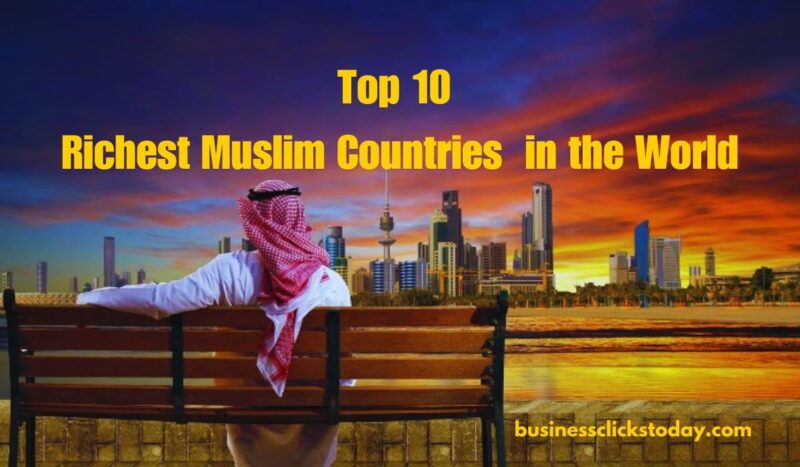The prominence of Muslim countries on the global wealth stage is often attributed to their substantial oil and natural gas reserves. These resources have enabled many of these nations to secure high positions in global wealth rankings. Consequently, it’s not surprising to see the assumption that Muslim countries are among the richest in the world. This notion holds considerable truth, as the substantial revenues from oil and gas have contributed significantly to their wealth. However, it’s essential to recognize that many of these nations are actively diversifying their economies, reducing their reliance on these traditional sources of income. To understand how these countries are evolving, let’s delve into the top 10 richest Muslim countries in the world as of 2024.
Top 10 Richest Muslim Countries in the World 2024
1. Qatar
At the top of the list of the richest Muslim countries in the world is Qatar. This small but affluent nation boasts a remarkable GDP per capita of $118,150 in 2024. Qatar’s wealth is primarily derived from its vast reserves of natural gas and oil, making it one of the leading energy producers globally. The 2022 FIFA World Cup hosted in Qatar significantly boosted the country’s infrastructure investments and increased global attention on its economy. The country has leveraged this opportunity to enhance its financial, construction, and service sectors, demonstrating substantial development and prosperity.
2. United Arab Emirates (UAE)
With a GDP per capita of $92,950, the UAE stands out as a prime example of how a country can thrive beyond its oil reserves. Comprising seven emirates, including Dubai and Abu Dhabi, the UAE has captivated global attention with its ambitious projects and developments. The country’s wealth stems from diversified investments in real estate, tourism, aviation, and renewable energy. Strategically located as a vital trading hub between East and West, the UAE continues to flourish as a vibrant business center.
3. Saudi Arabia
Saudi Arabia, with a GDP per capita of $71,370 in 2024, is renowned as a leading oil-producing nation. The kingdom is currently undergoing a significant transformation with its Vision 2030 plan. This strategic initiative aims to reduce the country’s dependency on oil and enhance various public services such as healthcare, education, and tourism. Investments in technology and renewable energy are also key components of this plan, representing a concerted effort to reshape the nation’s economic landscape.
4. Bahrain
Bahrain, with a GDP per capita of $62,750 in 2024, showcases a strong financial sector supported by innovative banking and financial policies. Although oil and gas play a role in its economy, Bahrain is increasingly focusing on heavy industries, banking, and tourism. The country’s liberal trade environment and emphasis on post-oil economic development highlight its progress and adaptability in the Gulf region.
5. Kuwait
Kuwait’s GDP per capita stands at $53,760, reflecting its significant oil reserves, which account for about 10% of the world’s total. The country’s wealth is closely tied to investments through the Kuwait Investment Authority, the oldest sovereign wealth fund globally. Kuwait is actively pursuing economic diversification through its “New Kuwait” development plan, which aims for sustainable growth across various sectors beyond oil by 2035.
6. Turkey
Turkey, with a GDP per capita of $43,620, exemplifies a robust and diversified economy. Its strategic location bridging Europe and Asia, coupled with vibrant industrial and agricultural activities, bolsters its economic strength. The country’s growing tourism sector and youthful population contribute to its dynamic local markets and workforce. Additionally, Turkey’s focus on infrastructure and technological advancements has provided a significant boost to its economic growth.
7. Oman
Oman, with a GDP per capita of $40,020, relies less heavily on oil compared to some of its neighbors. The country is making strides in diversifying its economy by investing in tourism, shipping, and logistics. Located along the southeastern coast of the Arabian Peninsula, Oman is developing its ports, free zones, and tourism sector to reduce its dependency on oil and enhance its economic prospects.
8. Malaysia
Malaysia, with a GDP per capita of $39,070, demonstrates a diverse economy driven by manufacturing, services, and natural commodities such as palm oil and rubber. The country has a strong track record of value addition in manufacturing and is a leading exporter of tech products, including semiconductors and electrical items. Malaysia’s national vision focuses on becoming a developed nation by 2020, with a knowledge-based economy driven by technology, biotechnology, and services.
9. Kazakhstan
Kazakhstan, with a GDP per capita of $34,480, is a notable Central Asian player with rich natural resources, including oil, gas, and minerals. The country is actively working to diversify its economy through agriculture, finance, and technology, guided by its “Kazakhstan 2050 Strategy.” Its extensive territory and strategic location make it a key trade conduit between Asia and Europe.
10. Libya
Despite ongoing political and economic challenges, Libya’s GDP per capita stands at $26,530. The country’s wealth is largely derived from its substantial oil reserves, which contribute significantly to its GDP and exports. However, persistent unrest has hindered economic progress and oil production. Libya’s path to stability and prosperity will depend on national reconciliation and efforts to rebuild its economy.
Conclusion
The list of the richest Muslim countries in the world showcases a remarkable array of nations with significant wealth and economic potential. While oil and gas have historically played a crucial role in their prosperity, many of these countries are now embracing diversification to secure their future growth. As these nations continue to evolve and adapt, they are likely to maintain their prominent positions on the global wealth stage. The continued development and strategic planning of these richest Muslim countries ensure that their influence on the world’s economic landscape will persist for years to come.a
















